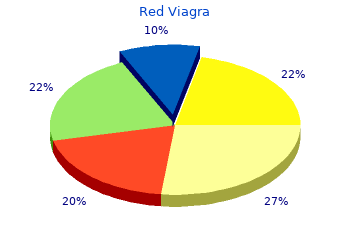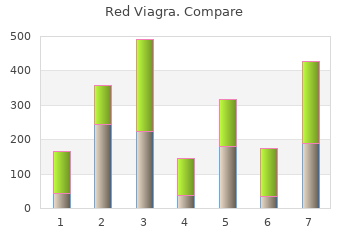Red Viagra
By K. Grimboll. Framingham State College. 2018.
Software is available for calculation of the 06 ratio between the alleles from the tumor and wild type (Hansen and Justesen buy 200mg red viagra mastercard, 2003). The optimal sample is the micro-dissected tumor tissue 09 without traces of non-malignant cells, but the majority of studies are made on tumor 10 tissue containing a certain fraction of non-malignant cells. The cut-off level should 11 be evaluated for each tumor type and for each analyzed panel since the amount of 12 non-malignant cells may vary between different panels. The cut-off level described 13 in the literature varies from a 50% to 16% decrease in allele intensity (Gaki et al. The choice of cut-off value influences the conclusion 15 tremendously when correlated with prognostic parameters of the patient cohort. Especially in studies on the association to prognosis it is important to obtain 22 information on each tumor from each loci. If a more detailed picture is needed for a narrow region with few genes, results 35 from expression arrays may provide an answer. Tha initial screen is performed with highly polymorphic microsatellite markers along the chromosome. The exact position of a breakpoint 37 is important especially when it affects the transcription unit of a gene. No mutations or promotor hypermethylation 30 are present to affect the protein function. An incorrect position of just one marker could influence 34 the entire flanking linkage map of the genome and the target gene is overseen. As can be seen from the table 39 a few regions turn up from several studies showing the strongest association with 40 prognosis. These regions should be further analyzed in large cohorts, the regions 41 should be further narrowed to isolate the region or the gene that carries the strongest 42 prognostic potential. Tissue 15 specific arrays are analyzed via immunohistochemical techniques and provide infor- 16 mation on the protein expression level of selected proteins within each tumor. Targets providing a statistical correlation to any prognostic marker in a 24 representative cohort, from the initial whole-genome screening, can be selected for 25 the design of new arrays directed specifically towards a prognostic or predictive 26 diagnosis. The microarray technology is 36 without doubt a very powerful tool to define new prognostic markers (prognostic 37 profiles consisting of multiple up or down regulated genes), refine the tumor classi- 38 fication, generation of a personalized genetic profile useful for the determination 39 of optimal type of treatment, and eventually in developing new targets of therapy. A decrease may be due to allelic loss affecting the whole gene or 42 the promotor region, chromosomal breaks, nonsense mutations, methylation of the 43 promotor region and lesions affecting enhancer elements. Different pathways to identify new prognostic markers for the outcome of breast cancer 30 31 elements, hypomethylation of the promotor region, and gain of function mutations. Specific algorithms are 04 developed to calculate the differences in expression level of each analyzed gene 05 (spot). The tumors are thereby divided into hierarchical clusters defined by the 06 expression pattern across the chip. This classification is solely based upon the gene expression pattern with no 18 inclusion of any clinical endpoints and is designated unstructured cluster analysis. The luminal subtype and C presents 21 the worst outcome, with a short time to recurrence. These five subgroups 29 represent significantly different correlations to the established prognostic parameters 30 and to survival and illustrate how heterogeneous breast tumors are. Fifty-eight genes were differentially expressed in the two 37 groups, and the separation of the two groups of patients was 100% accurate 38 (Tsumagari et al. The patients were divided into two groups, based 43 upon their gene expression pattern, one with a short interval to distant metastasis 44 and one without relapse within the follow-up period of at least five years. Further validation of 05 the prognosis classifier was performed on 295 patients both node positive and node 06 negative. The profile turned out to be a strong independent predictive marker for 07 outcome and more efficient than standard markers based on clinical and histological 08 criteria (van de Vijver et al. A prognostic profile including 76 genes was 09 derived using 115 node negative tumors and validated via 171 new tumor samples 10 (Wang et al. Despite similar clinical material only few genes were the same 11 in the prognosis classifier profiles from these two studies. Prospective systemic-therapy clinical trails should be designed with predictive 22 marker validation in mind (Brenton et al. Consensus 24 is hopefully reached between the large number of studies carried out world-wide, 25 and patients will eventually benefit from a diagnosis and a treatment resulting in 26 increased long-term survival and lack of unnecessary treatment. From these data several chromosomal 33 abnormalities can be deciphered like aneuploidy, interstitial deletions, non- 34 reciprocal translocations, amplification of small regions like insertions or double 35 minutes (Albertsen et al. By screening of 14 breast cancer cell lines, 24 independent amplicons, 06 each spanning from 0. This comparison 14 has in addition led to speculations on the connection between different chromosome 15 lesions and the pathway leading from a normal somatic cell to the different stages 16 of malignant growth and proliferation. The highly differentiated low-grade tumors (G1) show few 22 alterations as gain of 1q, 8q and a loss of 16q, and there is a clear association 23 between a high number of genomic alterations and a poor prognosis of the disease 24 (see Table 1). Abnormal changes in the methylation pattern 32 of a cell may cause severe inherited diseases, and is found implicated in (all) cancers 33 and in aging.

From this fact is can be seen that effective fly control programme calls for the involvement of all the neighborhoods or the community at large rather than households or food establishments alone purchase 200 mg red viagra overnight delivery. Life cycle Houseflies go through 4 stages of development: egg, larva, pupa and adult. Adult females can lay as many as 2,700 eggs in 30 days but more commonly lay 350-900 in 5 or 6 different batches. The eggs which are laid singly but often appear in clusters hatch in 6 to 24 hours. In wet breeding areas, full grown larvae climb to the surface or sides of the breeding media before pupating. The adult female is ready to lay eggs 2 days after 136 emergence and continues to lay eggs for about one month. It appears that flies continue to breed all year in low numbers in heated buildings such as dirty restaurants or incinerator rooms. In the spring these flies disperse to other buildings and increase in numbers rapidly. The female of the species can be seen depositing their eggs on suitable breeding materials. The female house fly lays individual eggs that pile up in masses of 75 to 150 eggs; in her lifetime, a single female house fly may lay up to 900 eggs. The female fly begins laying her eggs anywhere from 4 to 12 days from emerging from her pupae. In warm weather, the leg-less white pupae (or maggots) emerge from their eggs in 8 to 20 hours. This larva goes through three instars (or stages of development) in 1 week or less during warmer seasons, up to 8 weeks during cooler times. The house fly maggot and eggs depend on damp organic material in which to develop and feed. When it has completed its last instar, the fly maggot will move to a cool dry area in which to pupate. These larvae have confused many people by showing up far away from any possible breeding site. They have been known to travel over 100 feet to locate a suitable place to pupate. This pupation period besides conducive environmental conditions, such as availability of adequate 137 food and moisture, temperature is an important determinant for o o o breeding ranges from 29 C to 32 C, temperatures of 46 C or above o will kill the eggs and larvae; while temperatures below 7 C will retard or inactivate the development process. Under the climatic conditions of most parts of Ethiopia and that of most tropical countries, flies can breed throughout the year and the average life cycle may be completed between 8 and 16 days. Depending on environmental conditions, the average life span ranges from 30 to 45 days. Given the large number of eggs laid and the rapid rate of development, fly populations reach alarming proportions unless control measures are taken at an appropriate time. Breeding places Houseflies can breed practically in any moist, decaying or fermenting human, animal and plant wastes. Human excreta: whenever exposed in open latrines, seepage pits, septic tanks or in open field. Public Health importance Flies have been implicated as disease vectors fro thousands of years. Specially the housefly has been known to be the most dangerous contaminant of food, and transmitter of food borne and 138 other diseases. The explanation for this trait lies in its anatomical structure, peculiar breeding and feeding habits, and its close companionship to human beings and his habitations. In mechanical transmission of disease, the biological pathogens do not undergo developmental changes or multiplication, i. The fly breeds in open latrine, then carries pathogenic organisms from the faeces with its mouth part, legs and body, and crawls over the exposed food. The faeces-fly contaminated food is consumed by healthy persons, who eventually develop the diseases, in this case, enteric infections. Many investigators have also shown that outbreaks of diarrhoeal diseases and trachoma etc. The following steps will rid your home of house flies: Sanitation, Exclusion, Sprays, Baits. Sanitation for the House Fly Sanitation procedures not only include the obvious (clean trash receptacles, etc. Indoors, make sure that all trash cans are thoroughly cleaned before trash bags are used. All outdoor receptacles (dumpsters, trash cans) need to be cleaned regularly; they also need to have properly operating covers. Keep the areas around 140 dumpsters as clean and dry as possible; house fly eggs and pupae need damp material to develop and survive. Exclusion House flies enter homes by several means: doors which do not close properly or that do not have a good fit; windows without screens or with screens in ill repair. Flies also enter buildings through tiny cracks around windows and doors; seal or caulk these areas.

9 of 10 - Review by K. Grimboll
Votes: 108 votes
Total customer reviews: 108

